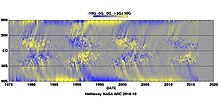Strip photography
The strip Photography is a process to create an image of sequentially captured image strips to assemble.
An aperture filters a narrow image strip perpendicular to the direction of movement. If the speed at which the film is drawn along behind the lens is adapted to the speed of the observation object, fast moving objects are shown in focus ( synchroballistic photography ).
In modern streak cameras , a mirror moves the image gap over a sensor. With long exposure of periodic processes, the strips can be arranged to form many individual images as a film sequence.
Examples
Observing the sun over several rotations provides values for the mean magnetic field depending on the latitude. Combined, the strips of the individual observation provide information about the variation of the magnetic field with width and time.
The second picture shows the afterglow of an illuminated semiconductor in false colors. The time axis runs vertically, the exposure strips are placed from top to bottom. In this technical recording, it is not the spatial extent of the semiconductor that is recorded, but its luminescence spectrum. The short-wave portion is on the right. The color values stand for intensities. No signal is detected with black, a small signal with blue, and an intense signal with red. The greater the wavelength, the faster the bright glow dies away.

